Montalcino, the Home of Brunello
Probably inhabited since Etruscan times, the hill upon which attractive Montalcino sits was mentioned for the first time in a document dated 814 AD, when Emperor Ludovico il Pio granted the land to the abbot of Sant’Antimo Abbey. In the 10th century, the settlement saw a sudden and remarkable increase in population, when people fleeing the nearby town of Roselle took up residence in Montalcino. The town reached its current size in the 14th century, like many Tuscan medieval borghi, it experienced long periods of peace, often enjoying a certain degree of prosperity. During the Late Middle Ages, Montalcino was still an independent and important commune thanks to its strategic location on the Via Francigena; however, it soon became a satellite of the more aggressive city of Siena and was deeply affected by the conflicts in which the city became embroiled. When Florence conquered Siena in 1555, Montalcino continued to resist for almost four years, but finally surrendered to the Florentines. It remained under the control of Florence until 1861, when the Grand Duchy of Tuscany was amalgamated into a united Italy.
Situated only 40-50 km away from Siena, Montalcino is mainly famous for the production of one of the world’s most delicious wines, Brunello di Montalcino, made from the Sangiovese Grosso grapes grown in the surrounding vineyards. This fleshy wine, which pairs well with grilled meat and game, is not the only wine produced in the area; Montalcino, in fact, is also very well known for its Rosso di Montalcino, a variety of Super Tuscan wines and Moscadello. Surrounded by the most breathtaking countryside in Tuscany – the Val d’Orcia – the town offers priceless views over the Asso, Ombrone and Arbia valleys, dotted with olive groves, vineyards and picturesque villages. The historic centre of Montalcino boasts many well-preserved medieval structures and a remarkable number of enoteche (wine bars & shops) lining its charming cobblestone streets.
Things to see and do in Montalcino
One of the first things you see as you approach Montalcino from Siena is the majestic pentagonal Fortress built in the second half of the 14th century atop the highest point of the town. This beautiful medieval structure incorporates some of the pre-existing southern walls, the keep of Santo Martini, the tower of San Giovanni and an ancient basilica, which is now the fortress chapel. A symbol of the Sienese resistance against the Spaniards and the Florentines, the Fortress of Montalcino offers fabulous views across the manicured countryside and is home to the most atmospheric enoteca in town, Enoteca La Fortezza di Montalcino, where you can have unforgettable wine tasting experiences.

Montalcino’s town square – Piazza del Popolo – lies a 5-minute walk from the Fortress and houses one of the loveliest buildings in Tuscany: Palazzo dei Priori. Also known as Palazzo Comunale, Montalcino’s town hall was built between the 13th and 14th centuries and is embellished with a tall and slender clock tower, probably the most popular landmark in town. Another building of interest on Piazza del Popolo is La Loggia, a Renaissance-style structure built between the 14th and 15th centuries.
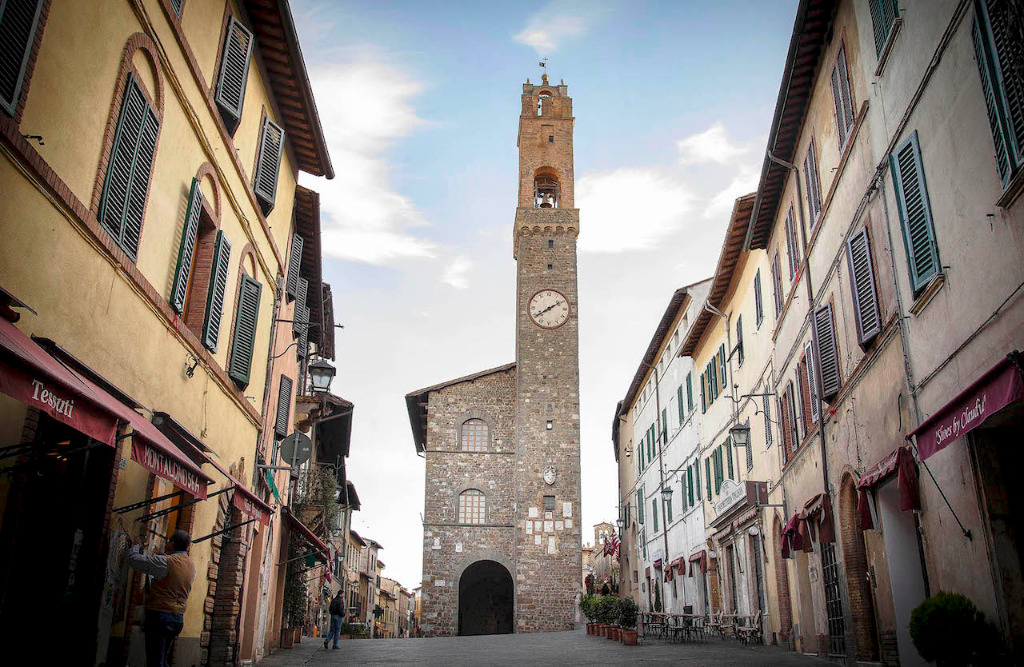
A short walk from the Fortress is also Palazzo Pieri (Via Ricasoli, 2), a delightful old building with a shaded courtyard. Built to house French soldiers during the French occupation of the town from 1555 to 1559, it is now a great place to wind down and have a drink.
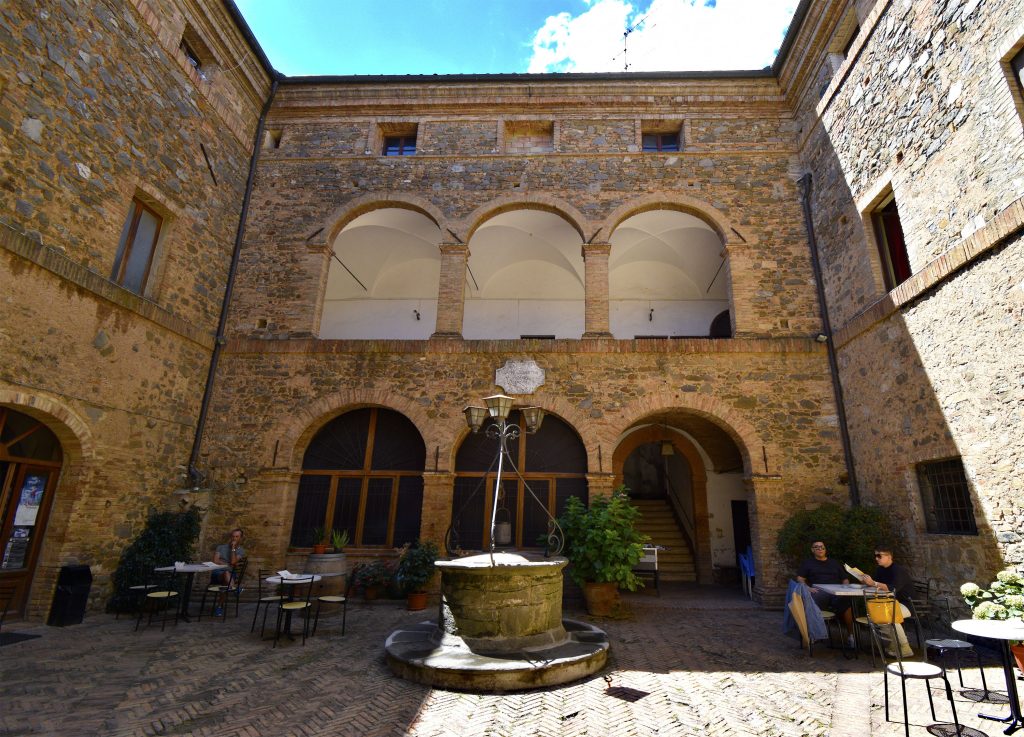
The Church of Sant’Agostino, with its simple 13th-century façade, lies just across the street from Palazzo Pieri and boasts some beautiful 14th-century frescoes by the artists of the Sienese school. Adjacent to the church is also the former convent, now a museum, with paintings and sculptures from the 14th century and artifacts recovered from archaeological excavations around the town.
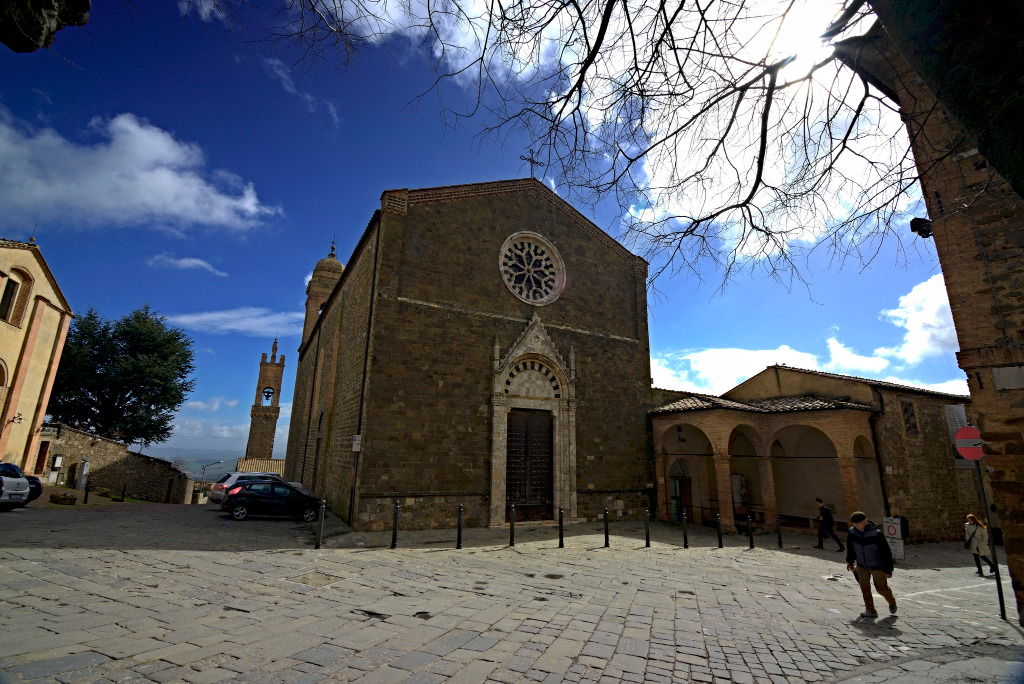
From the Church of Sant’Agostino, you can easily reach the Duomo di San Salvatore by walking along Via Spagni. Originally built in the 14th century, it was levelled and rebuilt into the present cathedral in 1832. The Duomo stands in the oldest part of town and offers a nice view of Montalcino.

Now look for Via Cialdini and follow this road until you get to Piazza Camillo Benso Conte di Cavour, a pretty, tree-shaded square with some benches and a fountain. Piazza Cavour is the ideal place for taking a break while visiting the town, there is also a nice restaurant with outdoor seating, which is perfect on a hot summer day.
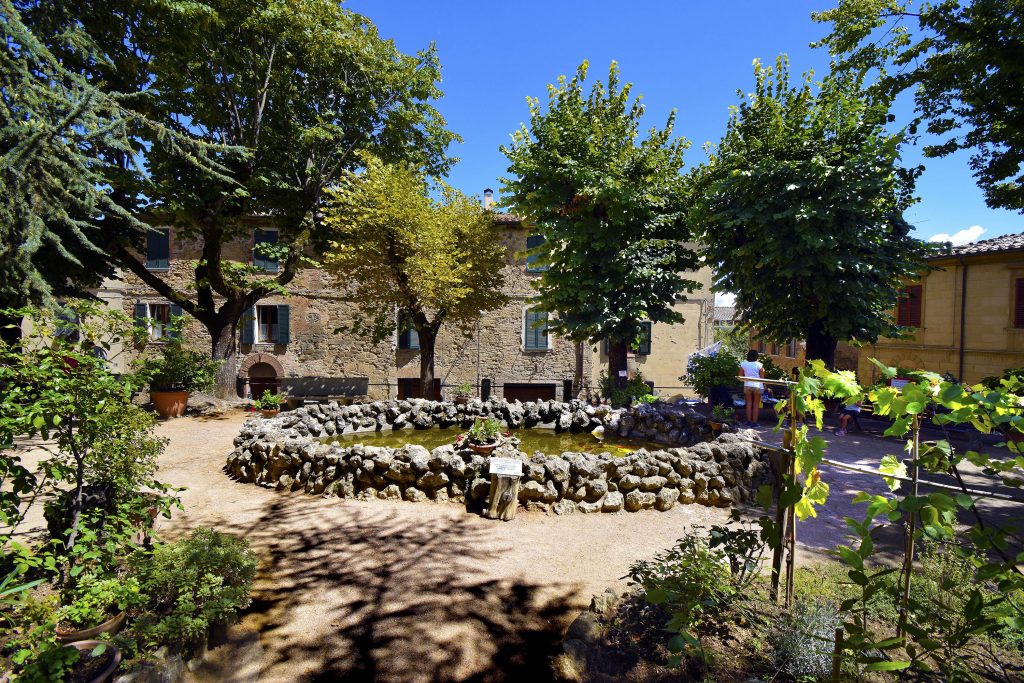
Not far from this piazza, at the end of Via Ricci, is another lovely church, the 13th-century Church of San Francesco, whose stone walls are the same colour as the Val d’Orcia in Summer.
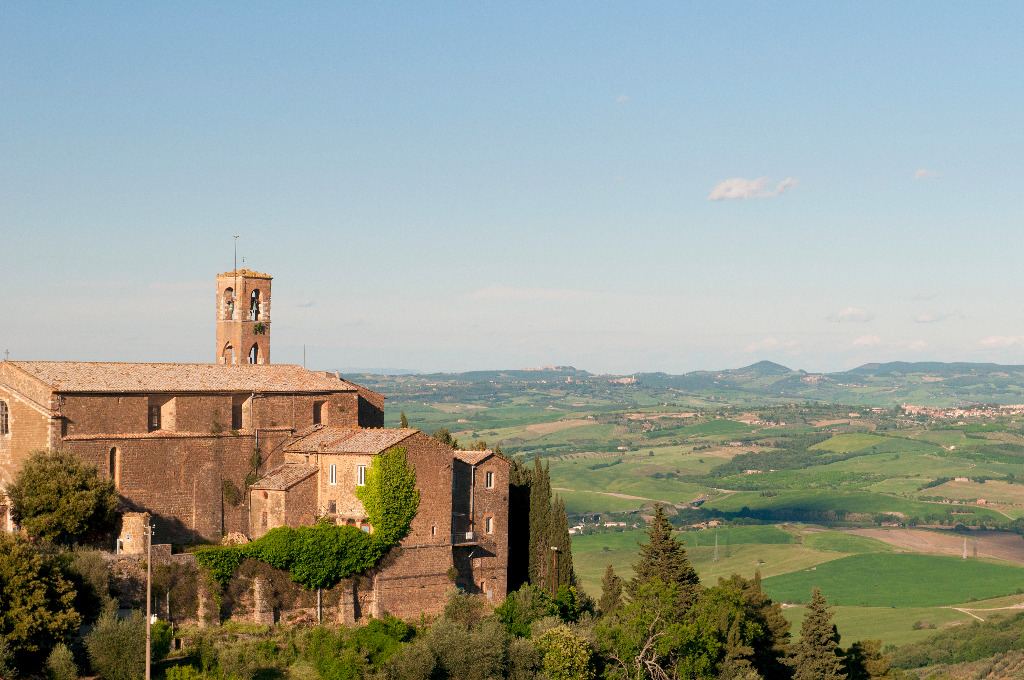
The Abbey of Sant’Antimo
If you’re visiting Montalcino and you’re not in a hurry, make time to see Sant’Antimo, a former Benedictine monastery deep in the amazing landscape of Val d’Orcia. Built in the early 12th century, this beautiful and solitary abbey is said to have been founded 300 years before, at the time of the Holy Roman Emperor Charlemagne, who is credited with founding the so-called Cappella Carolingia. Once a very powerful abbey, Sant’Antimo decayed to the point that in the 19th century it was used as stable; meticulously restored to its original splendour in the 1870s, it is now considered one of the most striking and picturesque buildings built in the Romanesque style.
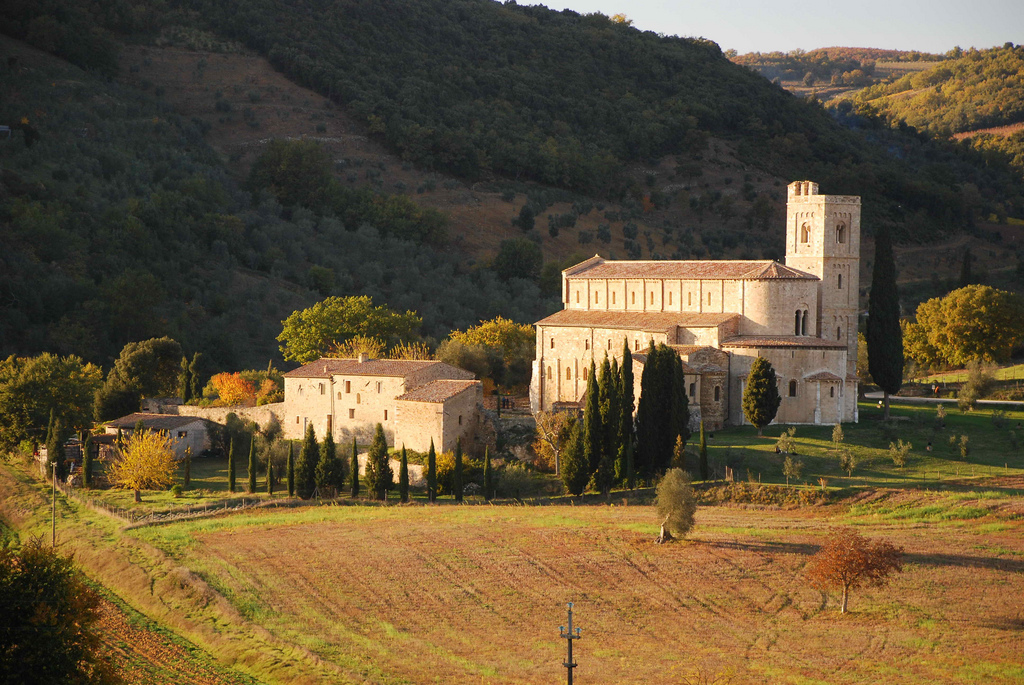
You can certainly get to Sant’Antimo by a chauffeur driven car but, honestly, the most pleasant way to reach the abbey is on foot. The hike is fairly simple and takes about 3 hours, we suggest you leave Montalcino around 9.30am so that you can arrive in Sant’Antimo at 1.00pm, when the monks start singing the Gregorian chants. So, are you in the mood for this long and nice walk? If your answer is yes, just follow the directions below.
At the roundabout located almost in front of Montalcino Fortress, take the road that leads to the cemetery (Via del Poggiolo) and keep walking on this road. Shortly afterwards, turn right onto the path that leads to Casa Albatreti, Gaetano Salvioni’s winery. The path continues through a wooded area; after crossing a couple of ditches, the path starts going uphill. Keep walking uphill until you reach the paved road that leads to Castiglion del Bosco. Turn left and continue uphill, ignoring the road that leads to Camigliano. Shortly afterwards, turn right onto Strada Provinciale Montalcino - S. Angelo (SP14) and keep walking until you see the lovely Agriturismo Le Ragnaie. Just across the road from Le Ragnaie is a gravel road (Strada Comunale della Villa a Tolli) that leads to the old, small village of Villa a Tolli, now an agriturismo. Take this road and follow it to Villa a Tolli, enjoying the stunning views over Mount Amiata and the Val d’Orcia. After the Agriturismo Borgo Villa a Tolli, the road continues basically downhill until you reach the beautiful and solitary Abbey of Sant’Antimo.
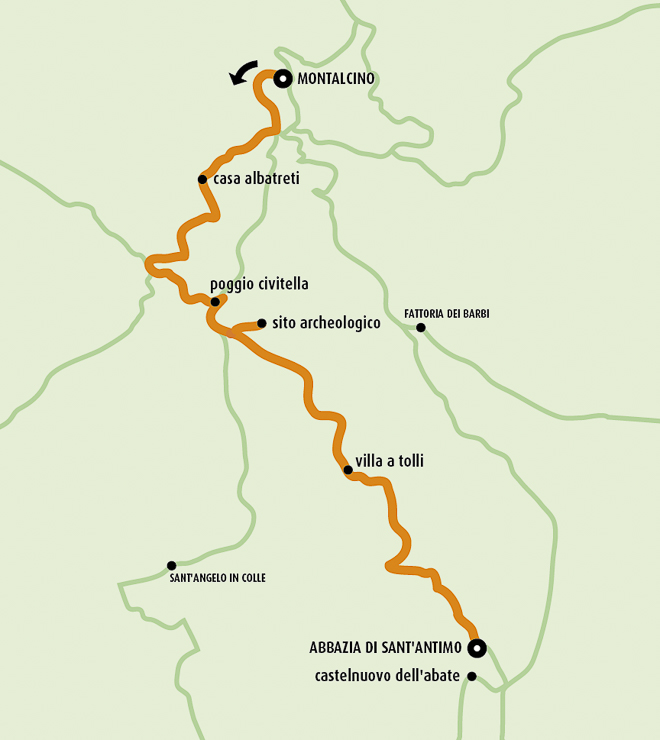
Montalcino is located to the west of Pienza, close to Bagno Vignoni, San Quirico d’Orcia and famous Crete Senesi. The town is 80 km from San Gimignano, 92 km from Volterra and 162 km from Pisa.



